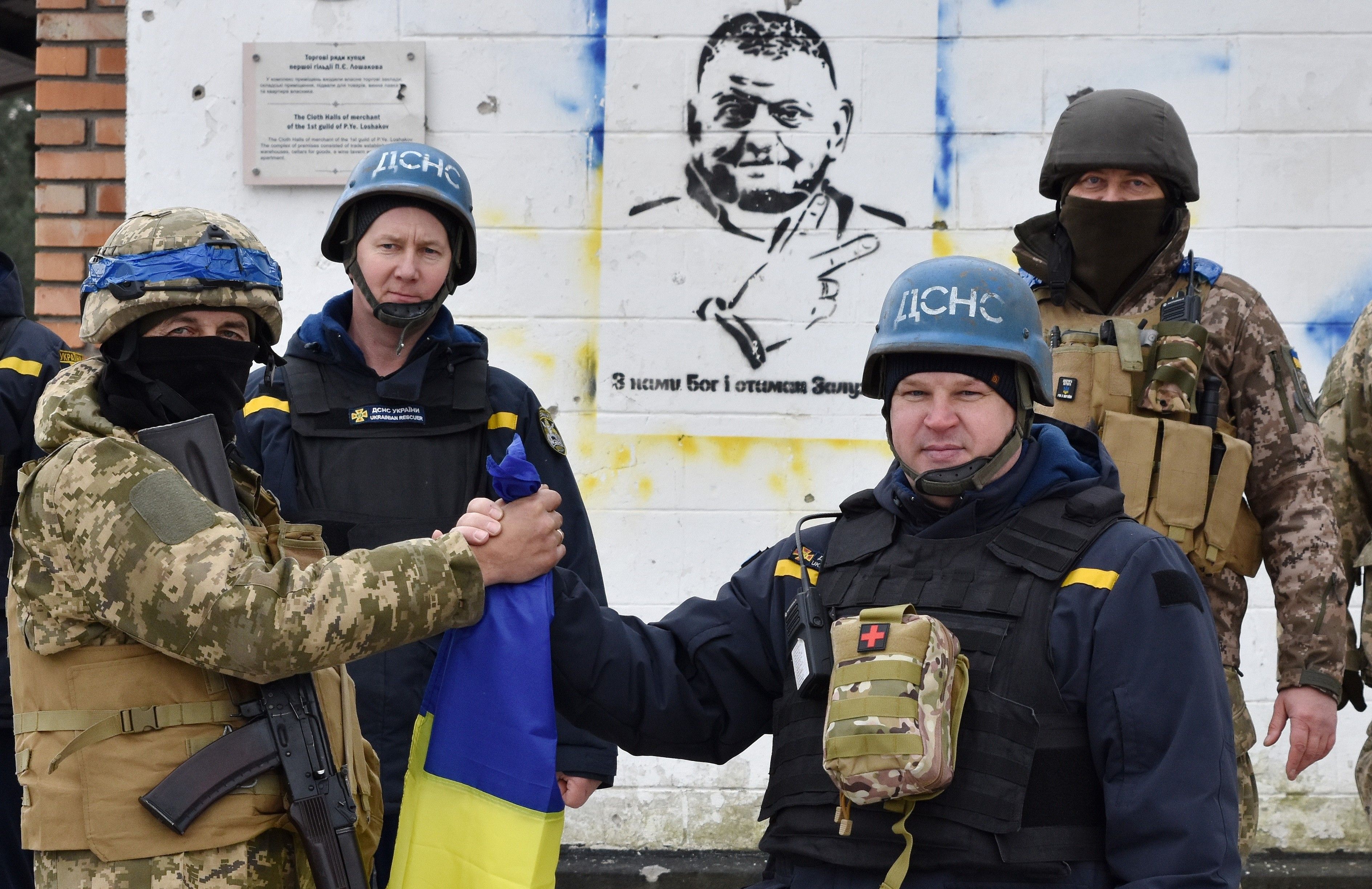President Volodymyr Zelensky’s dismissal of the Ukrainian army chief, General Valery Zaluzhny, is a colossal political gamble for Zelensky and seems to indicate an increasing mood of desperation in Kyiv. The background to this move lies in the failure of last year’s Ukrainian offensive, and the attempts both to shift blame and to draw up a new strategy that could promise Ukraine future victory.
The Ukrainian defeat last year led to a rather discreditable blame game in Washington, with the U.S. military, and some Ukrainians, suggesting that if Zaluzhny had taken their (supposed) advice and concentrated his forces to attack on a narrow front (rather than attacking in several places simultaneously), the Ukrainians could have broken through.
This is a rather odd argument, because it was just such attacks on narrow fronts that the Russian army tried several times immediately following the invasion, and that led to repeated disasters. It ignores the fact that just as U.S. satellite intelligence allowed the Ukrainians to identify local Russian concentrations and to concentrate in turn, so Russian satellite intelligence does the same when it is the Ukrainians attacking.
The truth is that by the summer of 2023 the Ukrainian army simply did not have the superiority in manpower and firepower that would have allowed it to break through heavily fortified lines manned by a numerous and well-armed enemy. To have succeeded against these odds would have been a quite exceptionally unusual event in military history. Nor is there any significant prospect that the Ukrainians will be able to succeed in the future; for even if they receive new Western weaponry over the next year, Russia will be using the year still further to fortify its defensive lines
Zelensky’s dismissal of Zaluzhny also reflects the fact that the general has long been seen as Zelensky’s most dangerous future political rival, given his prestige in the army and popularity among the Ukrainian people. We do not know how Zaluzhny will react to his dismissal. Perhaps he has made some deal with Zelensky.
The risks for the president are however obvious. Although Zaluzhny’s replacement, General Oleksandr Syrsky, also enjoys considerable prestige as the defender of Kyiv at the start of the war, he has been blamed by many Ukrainian soldiers for bowing to political pressure and throwing away Ukrainian lives in what was seen as an unnecessary and doomed attempt to hold the town of Bakhmut last year. There is also considerable resentment among the soldiers due to their impression that not only Zaluzhny, but the military in general are being scapegoated for last year’s failure.
Zelensky is not helped by the fact that after the Ukrainian defeat, he publicly rebuked and contradicted Zaluzhny for stating that the war had reached a stalemate and that Ukraine would now have to go onto the defensive — only then to accept Zaluzhny’s position when military reality (and advice from Washington) became overwhelming.
It is also not clear that General Syrsky’s appointment will change, or improve another critical factor that brought the tension between Zelensky and Zaluzhny to a head: conscription. A striking lesson of this war is that victory depends on a combination of the most recent weaponry with large numbers of fighting soldiers. In 2022, Russian defeats were largely due to the fact that they invaded with too few troops. The spectacular Ukrainian success in Kharkiv in September 2022 owed much to the fact that on that front they considerably outnumbered the Russians.
Today, however, Ukraine is running out of men. Russia has more than four times Ukraine’s population, and is conscripting more of them, as well as radically improving its tactics and weaponry. The Ukrainian army has been drained by huge casualties and growing unwillingness of the population to serve. The average age of Ukrainian soldiers is now 43 — far too old for full military effectiveness.
As a result, in recent months General Zaluzhny became more and more insistent on the need greatly to extend and toughen conscription. This was backed by the soldiers, and became entwined with their growing anger at corruption in Kyiv and the evasion of service by the sons of the elites. However, moves to tighten conscription and increase penalties for evasion of service met strong resistance in the population and among politicians.
As a result of this resistance, and perhaps of the unwillingness of the deputies to see their own children conscripted, the initial version of a law strengthening conscription was defeated in the Ukrainian parliament in January. Zelensky has reintroduced a softened version, but it is not clear that this will be nearly enough to compensate for Russia’s far greater population and resources.
Ukraine’s military prospects have also been drastically threatened by the refusal to date of Republicans in the U.S. Congress to agree to new aid to Ukraine. Without this, Ukraine will simply not have the weapons it needs to continue the fight. The European Union has agreed to a 50 billion euro aid package which will be critical to supporting the Ukrainian economy; but European officials have candidly admitted that Europe is in no position to replace U.S. military aid. Ukraine is therefore facing a double threat: of weapons without soldiers and soldiers without weapons. Should this continue, it is unlikely that Ukraine will even be able to sustain a defensive war of attrition against Russia.
Furthermore, even if the U.S. Congress reaches a compromise on aid to Ukraine, this issue will not go away for long. The struggle in the U.S. Congress — and particularly the role of former President Trump and his supporters in blocking a compromise — of course reflects political maneuvering as part of the U.S. presidential election campaign. However, the Republican stance also reflects a genuine feeling that extends across much of Europe and helps power the rise of the populist Right there: that the real threat to the security and stability of Western societies comes from domestic dysfunction driven in part by illegal migration; and that what happens in Ukraine is irrelevant to these issues.
Whatever one may think of the solutions being offered, it would be wrong and dangerous for advocates of support to Ukraine to dismiss these concerns. For if the war continues indefinitely, it will not be enough for Congress and the European Union to reach agreements providing aid to Ukraine for the coming year. They will have to do so next year, and the year after that, and the year after that. No Western government can seriously and honestly guarantee this.
Moreover, for Ukraine to stand on the defensive — even if it does so successfully — implies something that Western analysts and many Ukrainians are beginning to recognize, though few have as yet been willing to state this publicly: that if Ukraine remains indefinitely on the defensive, then the areas of Ukraine occupied by Russia will remain in Russian hands — not legally, of course, but de facto.
As I found while visiting Ukraine, even before the failure of last year’s offensive, a sizeable minority of Ukrainians were prepared in private to say that Ukraine should compromise with Russia and accept the loss of these territories, if the alternative was years of war and hundreds of thousands more deaths with no realistic prospect that these sacrifices would bring success. According to opinion polls, the defeat of the Ukrainian offensive has led to a significant increase in this sentiment.
The Ukrainian government and much of the establishment has however nailed itself to the principle that the only acceptable outcome is complete Russian withdrawal. Changing this position will be exceptionally painful and difficult; and one way of understanding the present political turmoil in Kyiv is that all the different figures and groups are trying to position themselves so as to throw the blame for eventual compromise with Russia on someone else.
The danger for Ukraine is that given the fraying of U.S. aid, the growing military odds in favor of Russia and the tensions reflected by Zaluzhny’s dismissal, if Kyiv waits too long to seek a compromise it may have nothing left to bargain with — not just because of developments on the battlefield, but because of the collapse of political unity within Ukraine.
- Diplomacy Watch: Ukrainian commander admits war is ‘stalemate’ ›
- Is this the beginning of the end of the war in Ukraine? ›
















